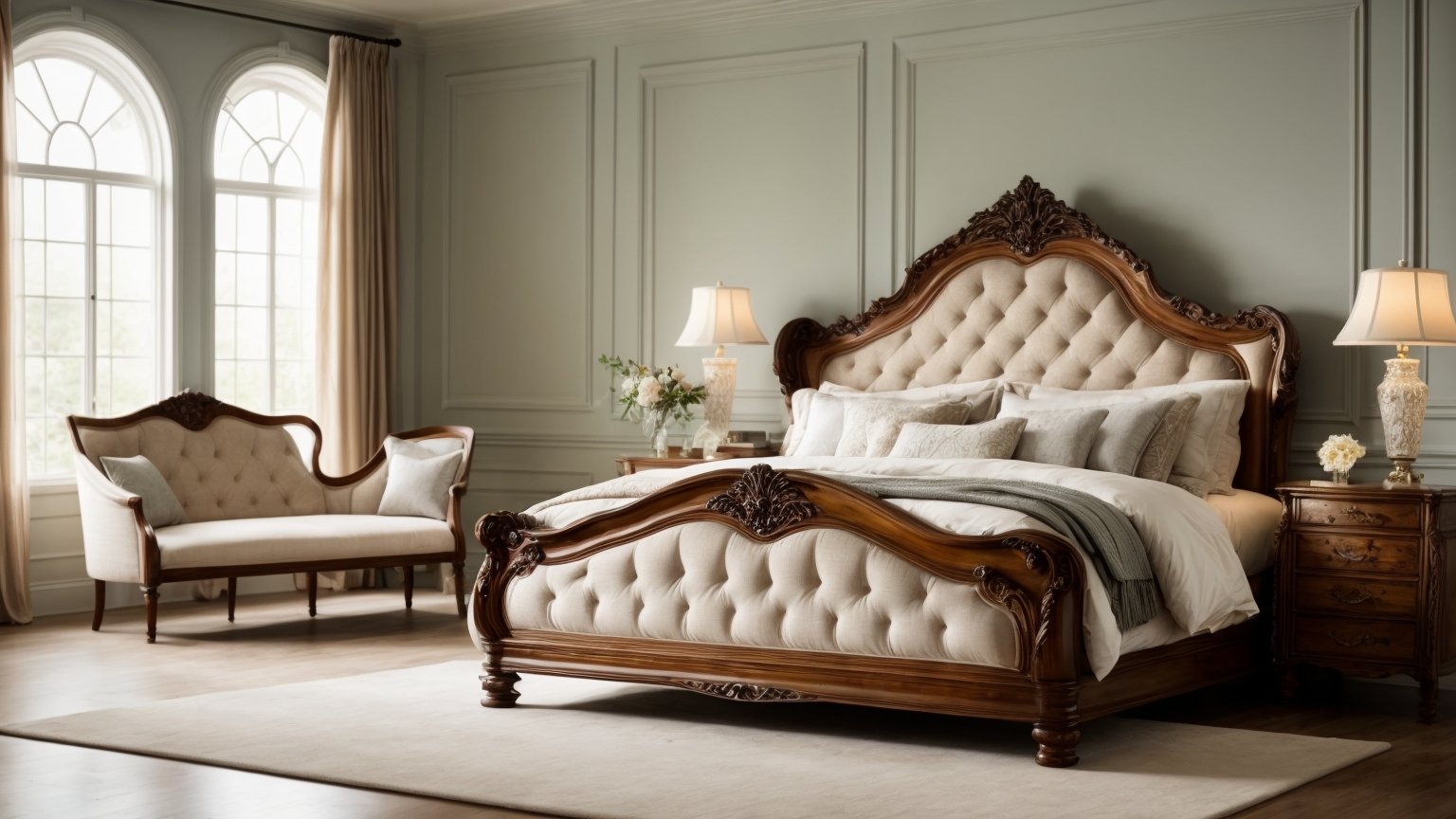Are you having trouble sleeping because your wooden bed frame is creaking and wobbling? A broken or weakened bed frame can cause discomfort and even lead to injuries. Fortunately, fixing a wooden bed frame is not as difficult as it may seem. With a few simple tools and materials, you can reinforce and repair your bed frame to make it stronger and more stable.
Before you start fixing your bed frame, it’s important to identify the problem. Is the frame cracked, split, or broken? Are the joints loose or damaged? Depending on the issue, you may need to use different techniques and materials. In this article, we’ll guide you through the process of fixing a wooden bed frame step by step, so you can sleep soundly and safely.
Identifying the Problem

If you’re experiencing issues with your wooden bed frame, it’s important to identify the problem before attempting to fix it. Here are some common problems you may encounter:
Loose Joints
One of the most common issues with wooden bed frames is loose joints. Over time, the joints can become loose due to wear and tear or improper assembly. To check for loose joints, give the frame a gentle shake. If you hear any rattling or feel any movement, then the joints are likely loose.
Broken Slats
Another common issue with wooden bed frames is broken slats. Bed slats are the wooden boards that support the mattress. If one or more of the slats are broken, then the mattress may sag or become uneven. To check for broken slats, remove the mattress and inspect each slat for cracks or splits.
Worn Out Screws
Finally, worn-out screws can also be a problem with wooden bed frames. Screws can become stripped or damaged over time, which can cause the frame to become unstable. To check for worn-out screws, inspect each screw and look for signs of wear or damage.
By identifying the problem with your wooden bed frame, you can take the necessary steps to fix it and ensure a good night’s sleep.
Gathering Necessary Tools
Before you start repairing your broken wooden bed frame, it is important to gather all the necessary tools. Here are some of the tools you will need:
Screwdrivers
A screwdriver is an essential tool in repairing a wooden bed frame. You will need both a flathead and a Phillips head screwdriver to remove and replace screws. Make sure you have the right size screwdriver for the job.
Wood Glue
Wood glue is necessary for repairing cracks and splits in the wooden bed frame. It is important to use a high-quality wood glue that will bond the wood together securely. Make sure the glue you use is appropriate for the type of wood you are working with.
Clamps
Clamps are important for holding the wooden bed frame together while the glue dries. You will need both C-clamps and bar clamps in different sizes to accommodate the different parts of the bed frame.
Sandpaper
Sandpaper is necessary for smoothing out rough edges and surfaces. You will need different grits of sandpaper, ranging from coarse to fine, to achieve a smooth finish.
Make sure you have all the necessary tools before starting the repair process. This will save you time and frustration and ensure that you can complete the repair successfully.
Fixing Loose Joints
If your bed frame has loose or wobbly joints, it can be a safety hazard and cause discomfort while sleeping. Fortunately, fixing loose joints is a relatively easy task that can be done with a few simple tools.
Materials Needed
Before you begin fixing loose joints on your bed frame, make sure you have the following materials:
- Wood glue
- Clamps
- Screws
- Drill
- Screwdriver
- Sandpaper
Steps to Fix Loose Joints
- Disassemble the bed frame: To fix loose joints, you will need to disassemble the bed frame. Remove the mattress and any bedding from the bed frame. Then, use a screwdriver to remove any screws holding the frame together.
- Clean the joints: Once the bed frame is disassembled, clean the joints using sandpaper. This will remove any dirt or old glue, ensuring that the new glue will adhere properly.
- Apply wood glue: Apply a generous amount of wood glue to the joint. Make sure the glue is applied evenly and covers the entire joint. Use a clamp to hold the joint together while the glue dries.
- Screw the joint: Once the glue has dried, use a drill to screw the joint together. This will provide added reinforcement to the joint.
- Sand the joint: Once the joint is screwed together, sand the joint to remove any excess glue and smooth out the joint.
- Reassemble the bed frame: Once all the joints have been fixed, reassemble the bed frame. Use screws to hold the frame together and ensure that all joints are tight and secure.
By following these simple steps, you can fix loose joints on your bed frame and ensure a safe and comfortable sleeping experience.
Repairing Broken Slats
If you have a broken slat on your wooden bed frame, don’t worry! It’s a common problem that can be easily fixed with a few simple steps. Here’s how to do it:
- Remove the broken slat: Carefully remove the broken slat from the bed frame. If it’s attached with screws, use a screwdriver to remove them. If it’s glued in place, use a chisel to carefully pry it loose.
- Measure the slat: Measure the length and width of the broken slat so you can purchase a replacement that fits properly.
- Purchase a replacement: You can buy replacement slats at most hardware stores or online. Make sure to get one that matches the size of the broken slat.
- Install the replacement: Once you have the replacement slat, simply slide it into place where the old one was. If it’s attached with screws, use a drill to secure it. If it’s glued in place, apply wood glue to the ends of the slat and slide it into place. Use clamps to hold it in place until the glue dries.
- Reinforce the slats: To prevent future breakage, reinforce the slats with metal brackets or additional screws. This will help distribute the weight of the mattress evenly across the slats and prevent any one slat from bearing too much weight.
By following these simple steps, you can easily repair a broken slat on your wooden bed frame. With a little bit of effort, you can save yourself the cost of buying a new bed frame and enjoy a good night’s sleep once again.
Replacing Worn Out Screws

Over time, screws in a wooden bed frame can become loose or stripped, causing wobbly joints and an unstable bed. If you notice this issue, replacing the worn out screws is a simple fix that can greatly improve the stability of your bed frame.
To replace the screws, you will need a few tools and supplies:
- Screwdriver
- New screws (matching the size and type of the old ones)
- Pliers (optional, for removing stripped screws)
First, remove the old screws by using a screwdriver to turn them counterclockwise. If the screw is stripped and won’t budge, you can try using pliers to grip the head of the screw and turn it out.
Once the old screws are removed, insert the new screws into the same holes and turn them clockwise with a screwdriver. Make sure the screws are tight and secure, but be careful not to overtighten and strip the wood.
If the old screw holes are too stripped or damaged to hold the new screws securely, you can fill the holes with wood filler and let it dry before drilling new holes for the new screws.
By replacing worn out screws, you can ensure that your bed frame is sturdy and stable, allowing you to get a good night’s sleep without any wobbling or creaking.
Finishing Touches
Once you have fixed the issues with your wooden bed frame, it’s time to give it a finishing touch. This will not only make your bed look good but also protect it from wear and tear. Here are some finishing touches you can do to your wooden bed frame.
Sanding
Sanding is an essential step in refinishing wooden bed frames. It helps to smooth out rough edges and surfaces and prepares the wood for staining or painting. Here’s how to sand your wooden bed frame:
- Start with a coarse-grit sandpaper and work your way to a fine-grit sandpaper.
- Sand in the direction of the grain to avoid damaging the wood.
- Use a sanding block to ensure even sanding.
- Wipe the bed frame with a damp cloth to remove any dust and debris.
Polishing
Polishing your wooden bed frame will give it a shiny and smooth finish. Here’s how to polish your wooden bed frame:
- Apply a small amount of furniture polish onto a soft cloth.
- Rub the polish onto the wood in circular motions.
- Let the polish sit for a few minutes.
- Buff the bed frame with a clean cloth to remove any excess polish.
By following these simple steps, you can give your wooden bed frame a professional-looking finish.
Preventive Measures
To avoid having to fix your wooden bed frame frequently, it’s important to take some preventive measures. Here are some tips that can help you keep your bed frame in good condition for a long time.
Regular Inspection
It’s important to inspect your wooden bed frame regularly to identify any issues before they become major problems. Look for cracks, splits, and loose connections in the frame. Check the slats to make sure they are not broken or sagging. If you notice any issues, fix them as soon as possible to prevent further damage.
Proper Usage
Using your wooden bed frame properly can help prevent damage and extend its lifespan. Here are some tips:
- Do not jump on the bed or use it as a trampoline.
- Do not overload the bed with too much weight.
- Do not drag the bed frame when moving it. Lift it instead.
- Do not use the bed frame for anything other than sleeping.
By following these tips, you can prevent damage to your wooden bed frame and avoid having to fix it frequently. Remember to inspect your bed frame regularly and fix any issues as soon as possible to prevent further damage.
